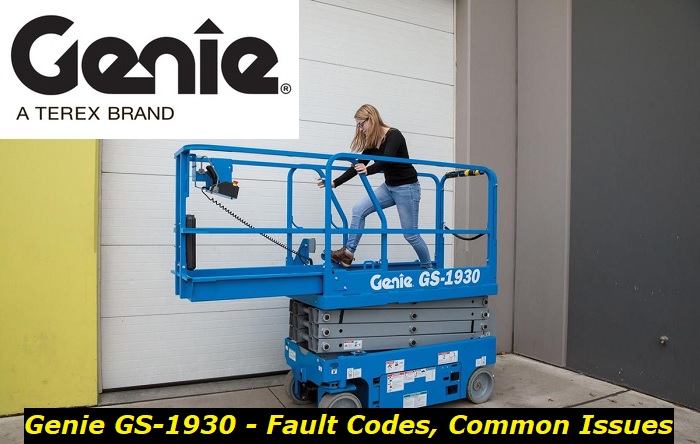Genie GS 1930: Fault Codes and Main Issues with Equipment
Fault codes on the Genie GS 1930 scissor lift are important because they provide users with diagnostic information to help identify and troubleshoot any potential issues. Fault codes inform users of the exact problem and allow them to quickly diagnose any issues that may arise, helping to reduce downtime.
These also help ensure the safety of all operators and users by alerting them to any potential hazards. By understanding fault codes, operators and users can take appropriate measures to ensure the safe and efficient operation of the Genie GS 1930 scissor lift.
In this article, we will identify the fault codes generated by the Genie GS 1930 scissor lift to help you familiarize yourself with the possible problems that may occur during its operation. The most common of them are highlighted here and solutions for each are made available for your easy reference and diagnosis.

Importance of Recognizing the Source of a Fault Code in the Genie GS 1930
As mentioned above, a fault code says a lot about whatever trouble is brewing in your equipment. So, correctly identifying a fault code surely provides a lot of advantages for users and technicians, such as the following:
1. Diagnosing the Problem Quickly and Accurately
Recognizing the source of a fault code in the Genie GS 1930 scissor lift helps to quickly pinpoint the issue, allowing for a more accurate diagnosis of the problem in order to determine the best solution for it.
2. Saving Plenty of Time
Knowing the source of a fault code in the Genie GS 1930 scissor lift saves technicians valuable time as they can immediately focus on the problem at hand rather than having to unnecessarily troubleshoot the entire system.
3. Ensuring Safety
Fault codes can provide vital information about potential safety issues, so it's important to recognize the source of the fault code in the Genie GS 1930 scissor lift to ensure the safety of both technicians and operators.
4. Reducing Downtime
With accurate fault code recognition, technicians can quickly troubleshoot and resolve issues, reducing downtime and allowing scissor lift operations to continue uninterrupted, thus, mitigating its negative effect on your productivity.
5. Preventing Further Damage
Recognizing fault codes in the Genie GS 1930 scissor lift helps to prevent further damage by identifying the issue before it is too late. This will help you avoid more hassle and more expensive repairs down the line.
Identifying the Different Fault Codes in the Genie GS 1930
When a possible problem is detected in the system of the Genie GS 1930, its LED diagnostic readout displays an alphanumeric code pointing out its possible source. The display will show you two characters that correspond to the fault plus a dot after them.
The resulting reading can be interpreted by referencing to the Fault Code Chart provided by Genie for the scissor lift. In general, the codes can be grouped as:
- "01" to "02" corresponds to engine control module (ECM) faults
- "03" refers to the DIP switch
- "12" points to the chassis
- "18" means the pothole guard
- "19" is linked to the Limit Switch
- "42" to "47" refers to platform-related components
- "52" to "59" signifies the coil
- "68" relates to the battery
- "LL" means it's off level
- "OL" says there's an overload
For the groupings, the specific area where the fault is detected is normally indicated by the first digit of the reading. For example, "01" leads to an internal ECM error while "02" suggests an ECM/Platform communication error. Again, refer to the Fault Code Guide of Genie found online or with the product for more details on the matter.
Most Common Issues Found in the Genie GS 1930
The Genie GS 1930 is reliable for the most part. However, there may be times when the gremlins in its system suddenly decide to cause mayhem during various operating conditions. When they do, the most common issues that you can expect from this piece of equipment are the following:
1. LL: Off-Level Fault
The "LL" readout in the display of the Genie GS 1930 normally means that the tilt of the scissor lift is more than its allowable level. It's normally coupled with the activation of the level sensor alarm.
Its service manual advises reducing the chassis angle to resolve the issue, which you should immediately try when diagnosing this particular problem. However, there may also be other factors at play here, which may still trigger the warning even though you have already corrected the leveling of the equipment's platform.
One of the other common causes of this issue is a failure in the level sensor switch or its wiring. This can be determined by doing an inspection on the wires and making sure there are no signs of damage, corrosion, or wear. If required, you should replace both parts to restore the equipment's normal operation. Additionally, you should also check the power supply to the sensor switch and make sure that it is properly connected.
Another cause of this problem is a failed leveling cylinder. This can be diagnosed by checking the fluid levels of the tilt mechanism's hydraulic system, making sure there are no visible signs of leakage or damage in its hoses. If needed, you should replace the sealings and internal gaskets of the system, too.
Finally, if all else fails you may need to replace the entire tilt actuator unit itself. Its sensors may have malfunctioned or been damaged beyond repair. Make sure that any new parts are genuine Genie replacements and meet their exact specifications before installation.
2. OL: Overload Cutout Fault
The "OL" warning in the Genie GS 1930 display points to an overload situation in its system. Normally, this occurs when a part of the lift exceeds its load limit, which is usually indicated by an activated overload indicator light.
A quick way to diagnose this problem is to check if any components are attached to its platform that exceeds its weight limit. Make sure that all components attached to the lift are compatible with its specifications and not too heavy for it to bear.
If there is nothing out of place, then it's time to check other potential causes such as the pressure switch sensor of the hydraulic system. This component may have malfunctioned due to internal damage, so you should inspect it for any signs of wear and tear. If needed, you can replace the component with a genuine Genie part that meets its exact specifications.
If all else fails then you may need to check the hydraulic pressure levels within the system. Its internal pump may have been damaged due to overpressure or excessive heat. Replacing this component may be necessary to bring the lift back to its normal operation. Make sure that you use a genuine Genie part and follow their exact specifications for installation.
Nevertheless, make sure that the overpressure indicator light is active before attempting repairs to prevent future damage to the system. You should also refer to the Fault Code Guide of Genie found in their service manual for a more accurate diagnosis of the issue. By doing so, you can ensure that the lift is properly maintained and any repairs are done in accordance with its specifications.
3. 68: Low Battery Voltage
Diagnosing the "68" warning displayed in the Genie GS 1930 requires a visual and electrical inspection of its battery. Check for any visible signs of wear, damage, burns, or corrosion on its casing. If you see heavy signs of corrosion, shorting, or damage, you should immediately replace the battery.
You should also check the overall voltage of the battery using a multimeter if there are no visible signs of problems with it. It should ideally be at least 12V, but if it is not, then this indicates that it needs to be replaced. You can refer to the service manual for exact specifications when replacing this component.
Furthermore, you may need to clean and adjust all connections from the alternator and regulator parts of the lift's power system. This ensures that there is no restriction of energy flow to the battery. Make sure that all components are secure and not damaged in any way before attempting repairs.
If replacing the battery does not solve the problem then you may need to check other parts of the power system, such as its alternator and regulator unit. This component can be easily tested by a professional technician, and if needed, replaced with a genuine Genie part that meets their exact specifications.
In either case, make sure that you use only genuine Genie parts for repair as they are designed specifically for this lift model. By doing so, you can ensure the proper function of the equipment and prevent future damage.
Conclusion
As shown above, there are many fault indicators in the diagnostic system of the Genie GS 1930. The most common though are those related to its platform inclination and height as well as the battery. No matter what problem you are encountering in your scissor lift, be sure to address it as soon as possible to avoid any more problems along the way.

Add comment